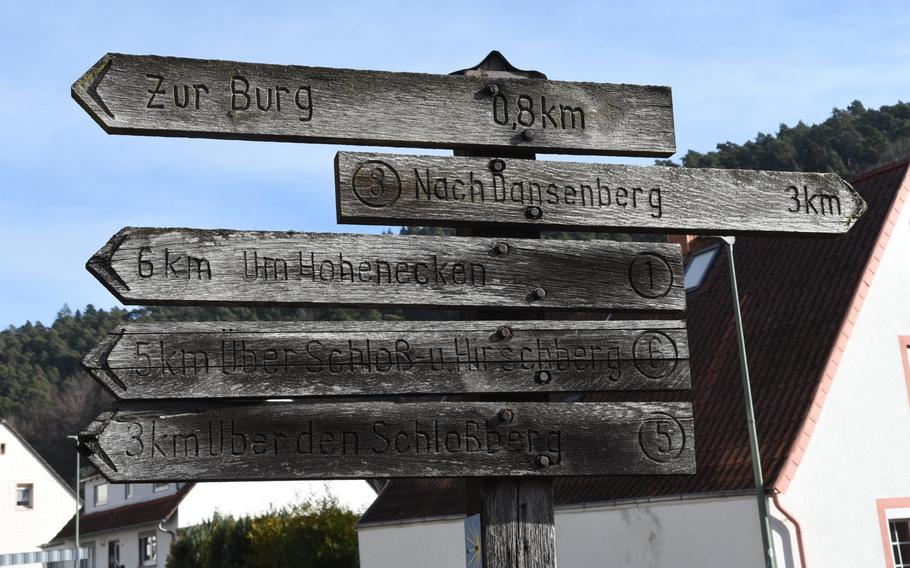
A weathered wooden sign in the village of Hohenecken points the way to the castle as well as other destinations along the forest's network of hiking trails south of Kaiserslautern, Germany. (Jennifer H. Svan/Stars and Stripes)
What Kaiserslautern lacks in culture it makes up for in history and nature.
The city to the south is blanketed by the Palatinate Forest, Germany’s largest contiguous patch of trees. Follow the network of trails and you’re bound to come across castle ruins, remnants of the Pfalz chain of castles built in the region during the Middle Ages to buttress the Holy Roman Empire’s western border with France.
One of the more prominent such ruins in the Kaiserslautern area is Hohenecken Castle. Built out of local red sandstone on a steep hilltop, the castle overlooks Hohenecken village and can be seen peeking above the trees by drivers heading south of Vogelweh on the B270.
For Americans living in Kaiserslautern, the castle is pretty much in your backyard and as such, it’s easy to take for granted. But it should be on everyone’s list of local day trips to do while stationed here.
I ventured up there on a recent February day, confirming that on the right day, not much can beat a winter hike in this area.
This was a rare gem of a day, with a clear, Wyoming-blue sky and the air crisp in the shade but warm in the sun.
The castle ruins are easy to get to but do require some legwork. Parking by the cemetery, I hoofed it past the quaint Rochus Chapel on a steep trail up into the trees. In less than 15 minutes, the trail opened up to a plateau on which was perched the Hohenecken castle ruins. As with many ruins, there’s mostly just partial walls and hollowed-out rooms left, but enough remains to light one’s imagination with images of what life on this hilltop might have been like in the age of nobles, knights and peasants.
The castle was built around 1200 to protect the red-bearded Frederick I Barbarossa von Hohenstaufen’s imperial palace in Kaiserslautern. Three hundred years later, rebellious farmers seized and occupied the castle, which was later partially destroyed by French troops.
The castle is part of an ongoing nationwide project in Germany to restore and protect significant cultural sites, a reflection of its importance to the history of the area.
The grounds appear to be well-kept and picnic tables and benches offer a place to linger a bit longer while enjoying sweeping views of the surrounding countryside.
A visit to the castle, however, need not be the end of one’s journey. If you’re feeling adventurous, take off on the trails that extend into the forest behind the battlements. The trails are well marked and you can walk to Dansenberg, the Bremerhof and beyond, making the day as vigorous and as long as you’d like while taking advantage of the ample hiking opportunities in the Kaiserslautern area.
svan.jennifer@stripes.com Twitter: @stripesktown
Directions: From Kaiserslautern and Ramstein, take the B270 south toward Pirmasens. Hohenecken is the first village after Vogelweh. Follow signs for the school, cemetery, church or the Burgschanke hotel and restaurant. Parking is available near the cemetery and church. Follow the path that leads behind the Catholic church, climbing uphill to the castle.Costs: FreeFood: Burgschanke is a good place to grab a bite to eat for lunch or dinner. It’s open seven days a week.Information: More information on the castle can be found on the city of Kaiserslautern’s website, at: kaiserslautern.de/start/index.html.en